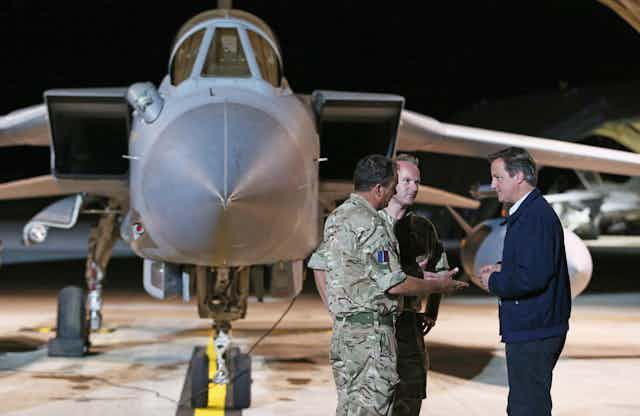The decision by the House of Commons to join the coalition of countries in a bombing campaign against Islamic State in Syria has raised questions about the size and capability of the UK’s armed forces. In his recent spending review, the chancellor, George Osborne, restated the government’s commitment that UK defence spending will continue to meet the NATO target of 2% in GDP and rise in real terms every year. This was generally seen as a significant change in direction, following a steady and long decline in Britain’s military budget.
After years of headlines about an increasingly impoverished Ministry of Defence, the idea that the UK was somehow lagging behind in its military prowess has become part of conventional wisdom. Commentators regularly quote military chiefs bemoaning cuts, while comedians crack jokes about the UK’s increasingly threadbare arsenal.
In a typical discussion of Radio 5 Live in the run up to the House of Commons debate on commencing air strikes in Syria, one caller referred the fact that the UK’s armed forces had been “decimated”.
The truth is very different. In a rare use of comparative data, the Telegraph recently reported that the UK is currently the world’s third biggest spender, behind only the USA (which spends more than half a trillion dollars every year) and China.
According to SIPRI, generally regarded as the most authoritative source on global military spending, the UK has, during the past decade, been well ahead of all its European neighbours except France (which spends roughly the same amount). The UK remains one of only a handful of NATO countries (alongside the US, France, Turkey and Greece) to continue to spend more than 2% of its GDP on defence.

The table to the left shows UK spending levels in dollars in real terms since 1990, based on constant 2011 prices and exchange rates (source: SIPRI). Spending fell following the end of the Cold war in the 1990s, but began to increase significantly from 1999 until 2010, actually exceeding Cold War spending levels before falling back a little from 2011 to 2014. The big increases occurred during Labour’s years in power – from 1997 to 2009, when spending went from $46,564m to $64,280m, before decreasing from 2010 during the coalition’s years in government.
Expenditure in most other European countries during a comparable period increased more moderately or – notably in the case of Germany – slightly decreased (Germany going from $50,229m in 1997 to $49,023m in 2009). In short, in the 21st century the UK has increased its military spending, in real terms, in ways that most of its European allies have not.
Myth of low spending
So why is it that people think that the past two decades – especially the Labour years – have witnessed an inexorable decline in British military spending? When we examined two decades of media coverage in the Times and the Guardian, we found a clear bias in coverage. Overall, news articles that generally favoured increasing military spending significantly outnumbered those suggesting levels should be maintained or reduced (as can be seen from the graph below). The argument for increasing spending was invariably based on the premise that it was in rapid decline.
A proportion (all-too-small) of the articles debated what the size of the UK defence budget should actually be.

More striking, however, was the shift in tone from the late 1990s. During the “peace dividend” years following the end of the Cold War in the 1990s, spending in real terms did go down – and press coverage featured a range of views about levels of defence spending. But the graphic below shows that when spending started to rise again however, the myth that defence budgets were still dwindling became increasingly fashionable, until this became the only view to receive any coverage.

Beating the drum
These headlines from a range of UK newspapers towards the end of the Labour years are fairly typical:


And finally from the Independent on Sunday, October 23 2011, quoting the UK National Defence Association (UKNDA), warning that unless ministers committed to increasing the defence budget to around 3.5% of GDP over the following three years, Britain should give up its “prized” seat on the UN Security Council.

If broadcasters used less dramatic language, they still give regular coverage to vested interests bemoaning “cuts” in military spending without balancing this view, or giving any comparative statistical analysis which might refute it.
The cumulative effect of this coverage has been to create a parallel universe in which, as the Times puts it, the “defence of the realm must always be associated with cuts”. Indeed, this has become a self-fulfilling prophecy: the military budget is “associated with cuts” because, despite increases, cuts is all we read about.
There is a reasonable argument to be made that in an age of austerity we should spend less on defence – perhaps more in line with the rest of Europe. But this distorted media climate makes a rational discussion of this issue very difficult.

